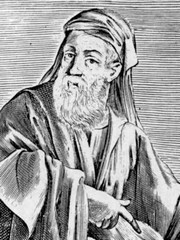| Empedocles of Agrigentum (ca. 495–430 BC). Greek philosopher, poet, physician, physiologist, politician, Empedocles was born in the city of Agrigentum, a Greek colony in Sicily.
Empedocles presented himself as an immortal god. Versed in magic and incantations, he was seen as a healer by people that followed him.
A philosopher, Empedocles developed the theory that nature consists of the combination of four “elements”— earth, water, air, and fire —with each of these elements being a combination of two qualities: water is wet and cold, air is dry and cold, fire is dry and hot, and earth is wet and hot. Empedocles went further to explain that the combination of these elements is based on the balance of love and hate. The balance of the elements represented balance in life.
Further development of this theory by observation of the human body, led to the “Humor theory” or “bodily fluids” theory based on four fluids whose imbalance led to disease. The four humors were “blood” or sanguineous, which belongs to the air element, “phlegm”, which belongs to water, “yellow bile”, which corresponds to fire, and “black bile” or “melancholy” which corresponds to earth. This theory dominated human physiology and medicine until the 17th century.
|
 |
| Because the humor theory also explained moods and temperaments, Empedocles’ influence is still seen in our language as we refer to people and personalities as “phlegmatic”, “sanguine”, “bilious”, and “melancholy”.
Empedocles’ death is the stuff of legend. To maintain his image as a god, he threw himself into the Etna volcano to disappear. This was foiled as it is said that the volcano spew one of his golden sandals. Others said that he made a “divinity” party and after dinner when everyone was asleep he disappeared, making everyone believe he had risen to heaven. Fact is, we do not know.
Sources
1. “Mythical Conceptions of the Problem of the Unity of Culture” Tagliacozzo, G. Am Behav Scient Apr 1963; 6-8
2. “The Nature and Formation of Teeth According to Spanish Authors from the 16th to the 18th Centuries” Romero-Maroto, M. J Dent Res (2008) 87(2):103-106
3. “The evolution of Modern Medicine” Osler, W. 2nd Ed. Yale University Press 1922
4. “Empedocles” N Brit Rev Vol LXV (1866) 420-440
|



